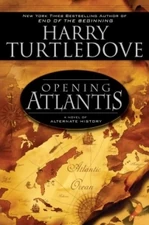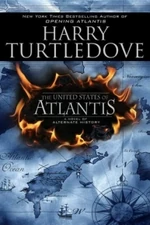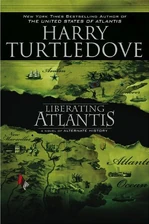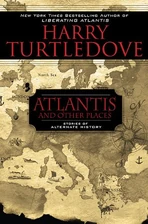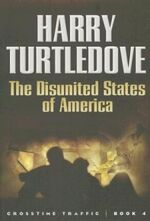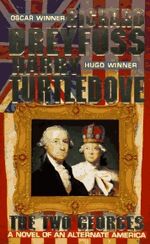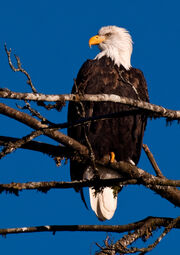
The bald eagle (Haliaeetus leucocephalus) is a bird of prey found in North America, with a range that includes most of Alaska and Canada, the continental United States, and northern Mexico. It is the national bird and symbol of the United States of America. The bald eagle's name derives from its adult plumage: its body is mainly brown, but its head is white. The bald eagle is primarily a picovore, meaning it mostly eats fish.
After spending much of the second half of the 20th Century on the endangered species list on the continental United States, the bald eagle made a substantial recovery thanks in large part to the banning of DDT.
Bald Eagle in Atlantis[]
The white-headed eagle remained common in Atlantis even as their larger red-crested cousins vanished.[1]
During the Atlantean War of Independence, Victor Radcliff saw a white-headed eagle and reflected that one of the eagle's favorite tactics was to wait for another bird of prey to make a catch, and then steal the catch from the other bird. Radcliff reflected that the white-headed eagle was fine symbol for Britain.[2]
Bald Eagle in Crosstime Traffic[]
A bald eagle, clutching 13 arrows in one claw, was depicted on the back of the American $100 coin in the home timeline.
Bald Eagle in The Disunited States of America[]
When Beckie Royer opened the envelope which Justin Monroe gave her at their parting, she found in it a curious coin, bearing the words "United States of America" and the date 2091 - an impossible anachronism, since she knew well that the United States had been a stillborn political structure which disintegrated and disappeared a few decades after its creation in the 18th Century. The bust of Benjamin Franklin on the obverse was familiar to her, but the design on the reverse - a Bald Eagle with 13 arrows in one claw - was completely incomprehensible.
Bald Eagle in Supervolcano[]
As Colin Ferguson drove by the Snake River on his way to Yellowstone National Park, he noticed a number of birders with binoculars and spotting scopes pulled over to the side of the road. He didn't pause in his traveling reflecting he might have if they were watching a bald eagle but not for some duck species he hadn't see before.[3]
Bald Eagle in The Two Georges[]
The bald eagle became a symbol for independence of the North American Union from Britain, both for the Independence Party who displayed it in the canton of their version of the Jack and Stripes[4] and for the Sons of Liberty. After an unsatisfactory meeting with Morton Johnston, Colonel Thomas Bushell expressed his frustrations by pointing out that the bald eagle was a perfect mascot as it was a carrion-eating scavenger that stole fish from hardworking seahawks.[5]
The Sons also used the flag and emblem. A police photo of Joseph Watkins showed he had a large tattoo of an eagle on his chest and a smaller one on his right bicep.[6] When Bushell searched his apartment he discovered that Watkins had an Independence Party flag nailed to a wall and a fierce looking crystal eagle perched on the mantel.[7]
When Bushell's investigation brought him to Boston, he interviewed the publisher of Common Sense, John Kennedy. On entering the premises of the publication, Bushell was confronted by a large painting of a bald eagle behind the receptionist's desk. The bird's eyes blazed and its beak gaped wide and fierce, quite unlike the real thing.[8]
Bushell's investigation finally brought him to Victoria. After a series of police raids led to the arrest of a number of suspects, the interrogations led to Bushell concluding that the The Two Georges was hidden in a storage locker. After unsuccessfully searching several facilities and with time running out, Bushell read out a list of remaining storage companies to his colleagues. When Bushell read out Adler Cubicles, he noticed Kathleen Flannery stir. When he asked her, she replied that Adler was the German word for eagle.[9] Having no other suggestions, the group went to Adler Cubicles. The front of the building had a bald eagle painted on it and a search of the units found one that was unlocked by a key that had been in the possession of a suspect. The painting was safe and sound inside.[10]
Literary comment[]
Bushell's description of the bald eagle's character is modeled on that of Benjamin Franklin's OTL argument for supplanting it with the turkey as the national bird.
References[]
- ↑ See e.g.: Atlantis and Other Places, pg. 23, HC.
- ↑ The United States of Atlantis, pg. 211.
- ↑ Eruption, pg. 6.
- ↑ The Two Georges, pg. 79.
- ↑ Ibid, pg. 82.
- ↑ Ibid, pg. 86.
- ↑ Ibid, pg. 99.
- ↑ Ibid, pg. 355.
- ↑ Ibid, pg. 543.
- ↑ Ibid, pgs. 544-545.
| ||||||||||||||||||||||||||||
| |||||
| ||||||||||||||||
| |||||||||||||||||||||||||
| |||||||||||||
